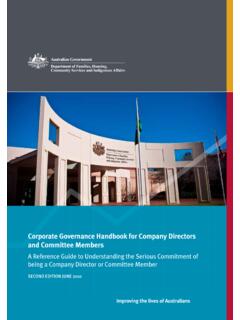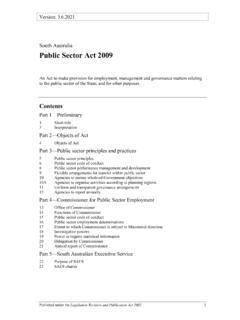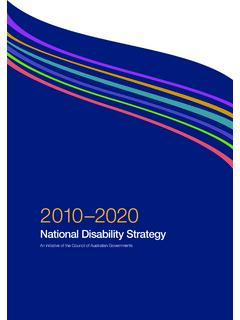Transcription of Sport Governance Principles
1 Sport Governance Principles MARCH 2020 CONTENTSP urpose of the Sport Governance Principles 2 The startline 6 Principle 1: The spirit of the game values-driven culture and behaviours 8 Principle 2: The team aligned Sport through collaborative Governance 10 Principle 3: The gameplan a clear vision that informs strategy 12 Principle 4: The players a diverse board to enable considered decision-making 14 Principle 5: The rulebook documents that outline duties, powers, roles and responsibilities 16 Principle 6: The playbook board processes which ensure accountability and transparency 18 Principle 7: The defence a system which protects the organisation 20 Principle 8: The best and fairest a system for ensuring integrity 22 Principle 9: The scorecard embedded systems of internal review to foster continuous improvement 24 The game is changing contemporary and stable Governance structures 26 Glossary and definitions of common Governance terms 281 PURPOSE OF THE Sport Governance PRINCIPLESU nderpinning the access to, and enjoyment of, Sport is the commitment and effort of sporting organisations across Australia.
2 In order to help these sporting organisations to deliver more positive Sport experiences more regularly, we are pleased to release the updated Sport Governance Principles . This document reflects the evolution of Sport Governance over the preceding decade. Sport is a key element of a cohesive and thriving national community. It is a tool for achieving outcomes in areas such as education, health, leadership development and fair play, and is unrivalled in its ability to link heart, mind and body, to connect individuals and to inspire communities. Increasingly, all sporting organisations are being held accountable for their Governance . Governance is not only relevant to large national sporting organisations; it is important for all organisations in our sector . It is for this reason that these Sport Governance Principles were co-designed through a whole-of- sector engagement. The clear message throughout the co-design was that no matter the size or maturity of the sporting organisation, there was a need for educational and accessible Principles to help guide organisations to good Governance .
3 There was also a clear need for the Sport Governance Principles to link to education, support and resources to transition the theory into practice. These Principles can be used throughout the australian Sport sector , from small local clubs to large national organisations, but the details and explanations tend to be most applicable to national sporting organisations and state/territory sporting organisations. Given the diversity of the Sport sector , the language used throughout the Principles might not align with or always be directly relevant to every Sport and organisation. A list of terms can be found in the Glossary, but it is worth highlighting the interchangeable nature of some of the key terms: Board (aka, board of directors; committee of management, council, committee), Director (aka, board member, committee member), and CEO (aka, executive director, general manager). For organisations that do not have a CEO, some sections may be less relevant but, equally, this role could be filled by directors or other volunteers in the organisation.
4 It is important to remember that good Governance is never static or fully achieved. As the leaders governing Sport we have an ongoing opportunity to change, to transform and to be better, but we need to be selfless, determined and focused on our purpose. These are attributes we expect of our elite athletes. They are also the attributes we see in our volunteers, grassroots participants and supporters. These Sport Governance Principles seek to support those who govern Sport to perform at a high standard as we look to modernise and continually embed good Governance in Sport in Australia. These Principles , as well as a full list of interactive tools, resources and education, can be found on the Sport Governance website. 234 The startlineThis section provides a basic understanding of Sport governanceGovernance is the system by which organisations are directed and controlled. It is the way in which expectations are made clear and the culture of the organisation is 1 The spirit of the game values-driven culture and behavioursAn organisation s culture and behaviours should be underpinned by values which are demonstrated by the board and embedded in its decisions and 2 The team aligned Sport through collaborative governanceAcross a Sport , boards should work together to govern collaboratively and create alignment to maximise efficient use of resources and implement whole-of- Sport 3 The gameplan a clear vision that informs strategy The board is responsible for overseeing the development of the organisation s vision and strategy as well as determining what success looks 4 The players a diverse board to enable considered decision-making A board should be a diverse group of people who, collectively.
5 Provide different perspectives and experience to facilitate more considered 5 The rulebook documents that outline duties, powers, roles and responsibilitiesAn organisation should clearly define and document its structure and the duties, responsibilities and powers of members, directors, committees and management. Principle 6 The playbook board processes which ensure accountability and transparency Through effective processes and continual review of its performance, the board is able to demonstrate accountability and transparency to its members and 7 The defence a system which protects the organisationTo proactively protect the organisation from harm, the board ensures the organisation has and maintains robust and systematic processes for managing 8 The best and fairest a system for ensuring integrity An organisation should have measures and protocols to ensure integrity of the Sport and safeguard its 9 The scorecard embedded systems of internal review to foster continuous improvementThe board must have an appropriate system of internal controls to enable it to monitor performance.
6 Track progress against strategy and address issues of game is changingContemporary Governance structures Sporting organisations should regularly consider how their Governance structures allow them to best achieve their purpose and respond to the challenges of a changing environment. Glossary and definitions Common Governance termsSport Australia Standards for Funded National Sporting STARTLINES tepping onto the field for the first time is daunting for a participant. What is the purpose? What are the rules? Who is on my team? What is my position? What is the spirit of the game? Being a director or a CEO, no matter the size or complexity of the organisation, can raise the same questions. This section provides a basic understanding of Sport Governance and is complemented by the is Governance ? An internet search will bring up many definitions of Governance . These definitions are often more confusing than helpful because of the amount of information and the complexity of the terminology.
7 At its most basic, Governance is the system by which organisations are directed and controlled. It is the way in which expectations are made clear and the culture of the organisation is modelled. The following lists further clarify what Governance is and is IS: The brain the thinking and monitoring part of an organsiation Leadership in terms of purpose, strategy and values The structures and processes for decision-making in an organisation Ongoing, deliberate and proactive A set of checks and balances for managing risks A method for evaluating organisational performanceGOVERNANCE IS NOT The body the doing and running of an organisation A recognition of long-term service to a Sport An organisation s day-to-day and week-to-week activities A secondary, sporadic thing to be done when time permits A reactive process when things go wrong Box-ticking to receive fundingGood Governance does not guarantee success; however, poor Governance almost certainly guarantees failure.
8 Much like a coach develops a training plan and goals for a team, Governance helps set the purpose for an organisation, its vision and how it will get there. For a gameplan to be effective, it is important to know the objective, the rules, the team members, and the team s approach. The same applies in S THE OBJECTIVE? Governance is having the processes and systems to enable good decision-making to help our organisation achieve its purpose. It is also about setting and exemplifying our agreed values and behaviours both individually and collectivley. WHAT ARE THE RULES?When governing, we must follow a set of rules. These rules are determined by legislation and the constitution agreed to by our members. The rules include policies and procedures which outline what we can and cannot S ON THE TEAM?Our Governance team includes the board of directors and, where there is one, the CEO, with the support of members.
9 We all have different roles to play including holding each other to account in achieving the best for the organisation. These roles are described more on the next S IT PLAYED?Our agreed values underpin our culture and guide our behaviours. Our culture is exemplified through our trust in each other and the confidence that comes from the support of our Governance TEAMMEMBERS Who the organisation exists to serve Granted powers under the constitution Elect directors to the board and approve major changes to the organisationBOARD The group of directors who hold ultimate responsibility for the organisation in accordance with the constitution Makes decisions based on what is in the best interest of the organisation and its members Sets, approves, and is accountable for the vision and strategy of the organisationDIRECTORS Individuals elected or appointed to serve on the board Have personal legal duties and responsibilities to the organisation Come together to make decisions as the board Exemplifiy the moral.
10 Ethical and behavioural expectations of the organisation and all its stakeholdersCEO An individual hired by the board to implement the organisation s strategy Directs and oversees the day-to-day operations of the organisation Is repsonsible to the board and provides information to help the board monitor progress and make decisionsWHY IS Sport DIFFERENT? Governance is a part of every organisation. So why do we need a specific set of Principles for the Governance of Sport ? The characteristics of Sport which produce a different Governance environment to that of the corporate or not-for-profit sector are outlined STRUCTURES There are often interdependent relationships between organisations within a Sport Most commonly found in the federated model (national, state/territory, clubs)LONG HISTORIES AND TRADITIONS Many organisations have long-standing traditions which can make change difficult Sport is reliant on volunteers who fulfil multiple and often conflicting roles Traditionally in Australia, Sport has grown from within communities or the ground upPASSION Even experienced directors can make decisions with their heart rather than their head The desire for on field success can override good Governance practices Directors often have an emotional connection to and investment in the Sport they are involved withA VARIETY OF PURPOSES A single organisation can have many conflicting priorities, with a tension between high performance success and participation growth For some sports .






